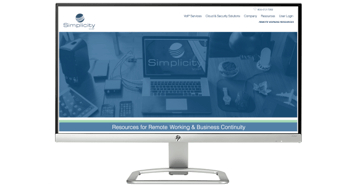VoIP Headsets: Types and Benefits
VoIP is booming! Most businesses have finally switched from traditional landlines to modern VoIP phone systems. This modern technology allows users to make and receive calls on their chosen device without the need for a conventional phone (often a landline). Users are no longer tied to their desks, office phones, or offices.
VoIP is much more cost-effective than traditional options, and you can further reduce the cost of buying equipment or phone lines. With that being said, you or your business can still opt to purchase accessories for your new VoIP system that can improve the overall call experience for users and customers alike. VoIP headsets, mobile apps, and conference phones are a few mentionable accessories that can help businesses get even more out of their new, modern VoIP system.
In this article, we will be focusing on VoIP headsets and going over the different types, benefits of each, and how they can help boost your call experience!

What is a VoIP Headset?
While VoIP calls can be made through any two internet-connected devices, you can still call landlines and other mobile phones with VoIP. Just because your side of the call is not on a landline doesn't mean you can't contact someone else still using a landline. One significant advantage of VoIP is that they can communicate with any other device connected to the internet, think laptop, desktop, VoIP-specific desk phone, cell phone, or a VoIP headset.
Many organizations opt to provide VoIP phones to their team members, who make many calls during their workday. An office may have a wide variety of VoIP phones, computers, VoIP headsets and equipment, and conference phones, depending on their type of business, budget, and specific needs.
A typical VoIP headset has either one or two small earpieces and a mini microphone that allows users to make and receive calls. Most headsets look similar to wireless headsets that some users use on mobile phones or even landlines. The most significant difference is that these headsets are optimized for VoIP technology.
How Do VoIP Headsets Work?
VoIP headsets are not complicated at all. Even the most technologically-challenged individuals can learn to use a headset successfully. The headsets connect to your computer or phone through a USB port. This enables you to communicate with the caller on the other side of the call. The USB port is typically what charges the headset while it is connected.
Wireless headsets eliminate wires and commonly utilize Bluetooth technology to connect with the base device. It forgoes the need to stay close or connected to your computer or phone and enables you to walk around while on a call and not remain stagnant in one place for your entire workday. However, it does mean that you must charge it regularly and separately when not in use. You will be alerted when the battery is low on your headset, whether a light or noise.
Most VoIP headsets are "plug and play." This means that there is no installation or setup required for users. You simply plug the headset into your chosen device and are ready to make and receive calls. However, some headsets come with drivers to ensure the headset and device are compatible. There may be an app available by the provider or manufacturer that offers additional features.
Benefits of VoIP Headsets
VoIP headsets offer users many benefits, especially for users who make and receive many calls per day. A good headset can make a difference for users who work in customer service, sales, or other customer-facing roles. Even if you don't tend to make many calls during the day, some users work remotely or train remotely, which can benefit users in comfort, productivity, and minimize hassles regarding answering calls.
Connectivity
Headsets allow users to stay connected constantly. If a headset is wireless, users are no longer tied to one spot or tethered to their computer. VoIP headsets allow users to answer calls from wherever they are. You can even configure your headset to answer calls automatically if needed, but most users prefer to use the button to answer and end phone calls.
Handsfree Options
Long gone are the days of using one hand to hold the phone and the other to take notes on an important business or customer call. VoIP headsets are made to be used for extended periods of time, so they are designed to be comfortable. Earpieces are padded and lightweight, and the headbands that hold the headset in place are also designed to be comfortable—no need to juggle pens, phones, and notepads with VoIP headsets.
Enhanced Call Quality
When coupled with a fast internet connection and robust bandwidth, VoIP calls are
indistinguishable from calls made on traditional devices, like landlines. However, when in an office environment, background noise is inevitable. This is where noise-canceling headsets can improve your call quality dramatically. They help to eliminate any background noise and improve your call experience.
These headsets are designed with the microphone closer to the user's mouth. It enhances clarity and minimizes any potential echoes. VoIP headsets are much better than using a computer and its speakers for phone calls, especially if you have a private conversation.
Productivity
While it may seem like a small addition to the office and call regimes, VoIP headsets can improve overall productivity for users, especially those who make dozens of calls each day. They enable team members to multitask and actively listen. This can include making notes during calls so crucial details are not missed. Users can move around, write things down easily, and more when not tied down in one spot.
Different Types of VoIP Headsets
Many different kinds of VoIP headsets come with various components to fit your business needs.
Wired vs. Wireless
Wired headsets must be connected to the user's phone or computer with a cord. The most common connection ports are 2.5mm jack, 3.5mm jack, USB or micro USB, or even mandatory vendor-specific adaptors. Vendor-specific opinions often will lock you into their products and make it harder and more expensive to change headsets in the future.
Wireless headsets most often utilize Bluetooth technology, but a few out there use DECT technology. While eliminating wires introduces the need to monitor the battery charge regularly. That being said, users must charge their headsets regularly.
Monoaural vs Binaural
Monoaural headsets utilize one earpiece that can be placed on either ear. Many users prefer this as it leaves one ear free to respond to someone within the office that may need them. However, if your work environment is rather noisy, binaural headsets may be the best option. They utilize two earpieces, so you get enhanced call clarity and volume.
Voice Tube vs. Noise Canceling
The microphone is just as critical to a headset as the earpiece(s). The standard voice tube does not provide any noise-canceling functionalities. These headsets are usually less expensive. Noise-canceling headsets use various filtering technologies to reduce background noise. While typically more expensive, they are essential for those who travel for work or work in hectic or loud environments.
Headband vs. Over-the-Ear
VoIP headsets are most commonly found in two styles. One is the standard headset configuration, much like the typical music headphone sets. They include some soft padding around the earpieces and a headband designed for extended use. Users can alter the fit of the headband for their specific needs.
Depending on the style, over-the-ear headsets rest on either ear or inside the ear. Some users do not like the weight of a headband on top of their heads or the feel of two pieces, cutting them off from their surroundings and ultimately reducing most outside noise. These headsets allow hands-free calling while still letting users keep an ear out for other noises around them (think your boss is calling you, fire alarm, etc.). Some headsets can even switch between the two styles, so you can select which mode you need for the call or your preference.
VoIP headsets are one of the most popular devices across industries worldwide. They can be used in the office or when working remotely. These headsets are accessible and vastly increase productivity.
Keep your business productive and effective while reducing costs. Let us help!





